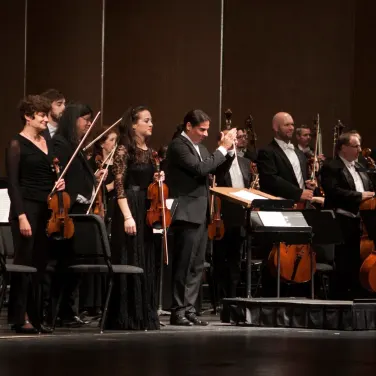
About
Genres
- american orchestra
Frequently Asked Questions
- How much does the Tucson Symphony Orchestra pay?
- The pay for musicians in the Tucson Symphony Orchestra can vary depending on the role, experience, and whether the musician is a full-time, part-time, or substitute player. As of recent reports, principal players in regional orchestras like the Tucson Symphony Orchestra typically earn between $10,000 and $30,000 per season, while section players may earn slightly less. These figures are influenced by the orchestra's budget, the number of performances, and the length of the season. In addition to base salary, musicians may receive additional compensation for special performances, rehearsals, and outreach activities. Administrative staff, conductors, and guest artists are compensated based on their contracts and roles. While the Tucson Symphony Orchestra may not offer salaries as high as major metropolitan orchestras, it provides valuable professional opportunities and a supportive environment for musicians passionate about classical and symphonic music. For the most accurate and up-to-date salary information, it's best to consult official orchestra resources or contact the organization directly.
- How long does a symphony show last?
- A typical Tucson Symphony Orchestra show, like most symphony orchestra performances, lasts between 90 minutes to two hours. This usually includes a short intermission of about 15 to 20 minutes, allowing audience members to stretch, use the facilities, or enjoy refreshments. The program often consists of multiple pieces, which might include an overture, a concerto featuring a soloist, and a symphonic work or two. The exact length depends on the specific repertoire chosen for the evening, but the Tucson Symphony Orchestra carefully curates its concerts to ensure an engaging and accessible experience for both newcomers and seasoned classical music fans. Patrons should plan to arrive early to find parking and be seated comfortably before the performance begins. If you're attending a special event or gala concert, the duration may vary, but the standard format ensures a captivating evening immersed in the beauty of live orchestral music.
- What's the difference between a symphony orchestra and a philharmonic orchestra?
- The terms "symphony orchestra" and "philharmonic orchestra" are often used interchangeably, but there is no significant difference in the type of ensemble or the music performed. Both refer to large classical orchestras comprised of strings, woodwinds, brass, and percussion, performing symphonic repertoire. The main distinction lies in the naming convention: "philharmonic" and "symphony" are simply ways to differentiate between multiple orchestras within the same city or region. For example, you might find both a "City Symphony Orchestra" and a "City Philharmonic Orchestra" in large metropolitan areas, each with its own administration and history. Regardless of the name, both types of orchestras provide the same rich, full-bodied sound and perform similar works, ranging from classical masterpieces to contemporary symphonic works. The Tucson Symphony Orchestra, for example, is a symphonic orchestra that delivers world-class performances, upholding a tradition of excellence in the arts and theatre category.
- What is the highest paid symphony orchestra?
- The highest paid symphony orchestra in the United States is the Chicago Symphony Orchestra, closely followed by other major ensembles like the San Francisco Symphony, Los Angeles Philharmonic, and New York Philharmonic. According to recent industry surveys and reports, base salaries for musicians in these top-tier orchestras can exceed $150,000 per year, with principal chairs and concertmasters earning significantly more through additional compensation and performance bonuses. These orchestras also benefit from strong endowments, robust ticket sales, and extensive touring, allowing them to offer competitive pay and attract world-class talent. The Chicago Symphony Orchestra in particular is renowned for its high artistic standards, international acclaim, and generous compensation packages, making it a coveted destination for professional musicians seeking both prestige and financial reward in the classical music world.
- Who is the director of the Tucson Symphony Orchestra?
- The current Music Director of the Tucson Symphony Orchestra is Maestro José Luis Gomez. Appointed in 2016, Maestro Gomez has brought fresh energy and artistic vision to the orchestra, elevating its profile in the regional and national classical music scene. A Venezuelan-born conductor with an impressive international career, Gomez is celebrated for his dynamic interpretations and engaging leadership style. Under his direction, the Tucson Symphony Orchestra has expanded its repertoire, developed innovative community outreach programs, and drawn celebrated guest artists to its stage. Maestro Gomez's commitment to musical excellence and education continues to inspire both musicians and audiences, ensuring the orchestra's enduring legacy in the arts and theatre category. For concert updates and more about Maestro Gomez's vision, visit the Tucson Symphony Orchestra's official website.